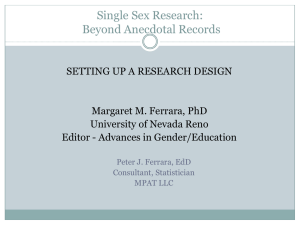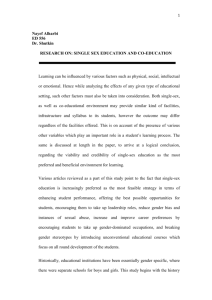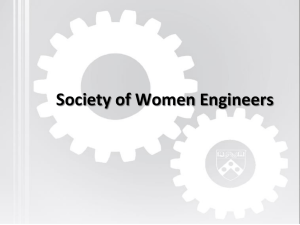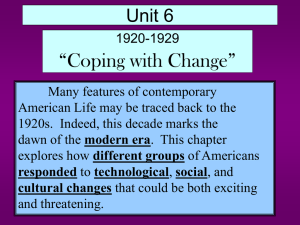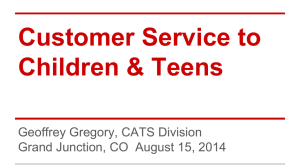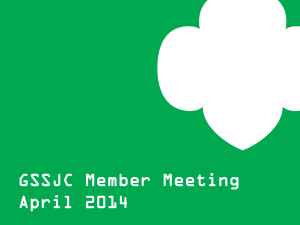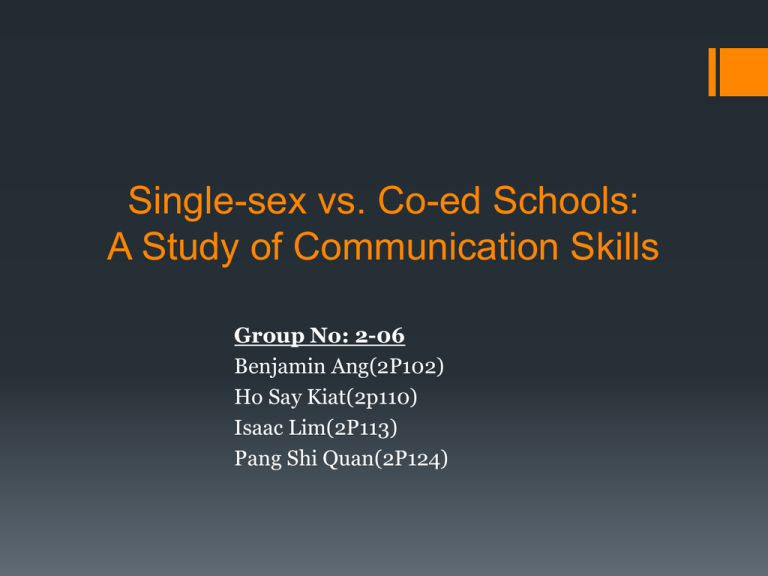
Single-sex vs. Co-ed Schools:
A Study of Communication Skills
Group No: 2-06
Benjamin Ang(2P102)
Ho Say Kiat(2p110)
Isaac Lim(2P113)
Pang Shi Quan(2P124)
Contents
1) Rationale/ Feasibility of Research
2) Thesis Statement
3)Research Questions
4) Literature Reviews (A, B and C)
5) Hypothesis
6) Methodology
7) Survey Questions
8) Future Areas for Research/Extension
9) Timeline
10) Acknowledgements/References
Rationale
•
•
•
We read some articles that mentioned:
Co-ed and single sex schools and their respective academic perfomance
93% of all teens have access to the internet
Approximately one third of teens said that they’ve become “close” with these people
they have met online
Thus, we felt that :
Is education all about academics? Is there any other reason that brought about the
“creation” of single sex schools?
Are social skills, a basic characteristic of life, slowly fading?
• Language definitely plays an important role when interacting with these people.
• When interacting with people online and face-to-face, we adopt a entirely new
character, person, and hence this might make one sound friendlier, hence, becoming
“close” with people they have met online
• Hence we thought, what affects this then? Is it possible that different types of
education might affect the language used online and during face-to-face
conversations, by students of the same age group ( aged 13-16 )?
Feasibility
What makes our project different from
current ones already available?
Through reflection and extensive research, we realised that
very few literatures spoke of social aspects of education, but a
lot spoke of academic aspects, taking into consideration the
society’s common mindset of “Academics is everything.”
Hence, we decided to take on a research from a different
angle-- social part of education, discovering at the same time
the difference in terms of social aspects between single sex
schools and co-ed IP schools.
Thus, we zoomed into a deeper understanding of the language
use online as well as language use when interacting face-toface, thus finding out more about the differences of students
from co-ed and single sex schools communicating(in terms of
expressiveness, openness, etc).
Thesis Statement
Thesis Statement
A study on the differing language uses by students
between single sex and co-ed IP schools of the
same age group(13-16). And its effects on social
skills of students, in terms of their abilities to
integrate with people .
Research Questions
1) What are the differences in language use on online social
media platforms, between students from single sex and co-ed IP
schools?
2) What are the differences in language use in face-to-face
interactions between students from single-sex and co-ed IP
schools?
3) What are the reasons for these disparities ( if any ) between
the language students from single-sex and co-ed IP schools?
Literature Reviews
Literature Review A
An excerpt from
http://www.universitylanguage.com/guides/co-edsingle-sex-schools/
:
“For one thing, student diversity suffers at a single sex school. In
addition, although it may be easier for students to participate actively
and do well academically at a single sex institution, the real world is
not single sex. It may prove difficult for students from single sex
schools to adjust to a co-ed atmosphere…”
“Co-ed schools are likely to offer you more in the way of student
diversity. Having both men and women in classes allow students of
both sexes to interact with a wider range of people and learn how to
work with and talk to people of the opposite sex.”
Literature Review A (cont’d)
We agree with this view point:
The source states that in Co-ed Schools, Students are
“given more chances to interact with students of the opposite
gender.” and “learn how to work with and talk to people of the
opposite sex.”
This implies that most students in Co-ed Schools should
be closer to students of the opposite gender, and will thus be
more familiar and experienced when communicating with
them.
In other words, students from Co-ed schools will be more
expressive and open in their language with students of the
opposite gender; similar to our hypothesis.
Literature Review A (cont’d)
The source also states that “For one thing, student
diversity suffers at a single sex school.”
This implies that students from Single-sex schools will not be
as comfortable and experienced at communicating with others of
the opposite gender, thus will be less open and expressive;
which is also similar to our hypothesis.
Literature Review B
A reply to the question : Are single sex schools a
good idea? on a debate site.
48% of users said YES, while 52% said NO.
By a user named - R0d0Ferdy
Source :http://debates.juggle.com/are-single-sex-schools-a-good-idea
Literature Review B (cont’d)
User R0d0Ferdy –
> Agreed that Single-Sex schools are better than Co-ed Schools
> He said that : “Students in this type of school have to deal
with a lot fewer distractions and can concentrate more
on their studies. There are plenty of opportunities to have
interaction with the opposite sex outside of the
classroom.”
Literature Review B (cont’d)
This also implies that Single-Sex schools are better
than Co-Ed schools. Students from single-sex schools
have adequate exposure to the opposite gender, to
allow them to be familiar and comfortable when
communicating with them.
Literature Review B Conclusion
However, we felt that :
> Teens spent majority of their time in school, and so it takes up
a large part of their social life.
> Teens will definitely not spend as much time outside as
opposed to school; and all the more less time with the
opposite gender, and actually interacting with them.
> Thus, teens in Co-ed schools would have more experience
communicating with the opposite gender, and will be more
comfortable and open when communicating with the opposite
gender, which will prove to be a plus point.
Literature Review C
A research paper : The Advantages of Single-Sex vs. Coeducational
Environments for High School Girls
By : Hartman, Kristen; Providence College, Providence, RI 2010
‘A project based upon an independent investigation, submitted in
partial fulfillment of the requirements for the degree of Bachelor of
Arts in Social Work.’
Link: http://digitalcommons.providence.edu/socialwrk_students/63
Literature Review C (cont’d)
“High school girls at Co-ed schools tend to base their
self-esteem on the opinion of their male peers. Many
girls are distracted by their male peers. They worry
that their assertiveness in class or extra curricular
activities will make the men in the school view them
poorly or make them feel less attractive (Monaco &
Eugene, 1992). Acceptance of others is important to
adolescent girls, and acceptance for many girls consists
of being accepted and well liked by boys. This is
dangerous in a co-ed setting and could hold female
students back from achieving what they deserve.”
Literature Review C (cont’d)
This implies that being in a Single-sex school is more
beneficial for high school girls, as they no longer have to
worry about the opinions of the opposite gender, and so
there will be more room for them to express themselves
freely, and achieve to their maximum potential.
This could be a potential reason for parents to send their
children to Single-sex schools, however, every rose has its
torns.
Literature Review C (cont’d)
“It is reported that single-sex education does not make women feel equal
during their high school years. It makes them feel inferior because separation
inadvertently tells girls they are not good enough to succeed among their male
peers. This separation suggests to women that they can only be successful
academically when male competition is taken out of the picture.”
“This separation is extremely unrealistic and does not prepare women for the
mixed gender society which they will be immersed in post graduation. Girls who
attend single-sex high school are unable to deal with the male competition in
their studies like their female peers who attended coeducational schools. These
single-sex graduates are not socialized in a mixed gender setting finding it
more difficult to succeed than in their prior single-sex environment. All high
school graduates will eventually be working or coexisting side by side with the
opposite sex, therefore it is important for high school girls to learn to work
cooperatively with the opposite sex before entering the real world.”
However, being in a Single-sex school will also have its inversed affects.
Being in a Single-sex school will also changed the mindset of the girls,
and make them rely on the lack of male competition to excel.
This serves as a downside for them, and the sudden male competition
when they leave high school may prove too overwhelming to them; and
cause them to underperform.
This would render their high school education in a Single-sex school
useless. No matter how well they performed in high school, if they fail
to perform later on in life, there isn’t much they can do.
This portion of the source shows the downsides of a Single-Sex School
that many others overlooked. Single-sex schools don’t just provide the
students with lesser distraction from the opposite gender, it also
isolates them from the opposite gender, thereby causing them to be
unfamiliar and inexperienced with interacting with them.
Literature Review C Conclusion
This source gives a balanced view of Single-sex schools. It allows us to see
the pros and cons of it, and evaluate whether the pros or cons matter more,
if either one overrules the other.
No doubt, the students despite being unfamiliar and inexperienced when
they enter the real world, and have to compete with males, they will
eventually adapt.
However, in the time they take to adapt, others from co-ed schools who
have the experience and familiarity, although they may not have excelled as
well in school, may also have used to time to catch up with the student
from a Single-sex school.
However since it is better to everything young, Co-ed schools may be the
better choice.
Literature Review Conclusions
Source A is for Co-ed Schools.
Source B is for Single-sex Schools.
Source C is for Both.
However, we rationalized that Co-ed schools seem to yield more
benefit for the students as,
1) They equip the student with the needed experience and familiarity of
communicating with the opposite gender.
2) Because they have the chance to interact so often with the opposite gender, they
will be more matured and understanding.
3)With social skills taken care of in school, they do not have to worry about it when
they enter society, unlike students from Single-sex schools, who although may be
more intelligent, do not know how to convey their ideas and thoughts, thus losing
out.
Hypothesis
Students from Single-sex schools are more open,
personal, expressive and informal with people of
the same gender, but less with people of the
opposite gender, of the same age group ( 13-16 )
Students from Co-ed schools are open, personal,
expressive and informal with people of both
genders, of the same age group ( 13-16 )
Methodology and Research Design
3
U Framework
Understand the
implications each
theory
presents/suggests
Uncover Theories
in Sources
Utilize these
findings to
make a
conclusion
Analysis and Evaluation Process
We plan to have 2 surveys:
1) Face-to-Face Survey
2) Online Survey
Target Audience: Students (13-16)
from IP schools
For the face-to-face Survey, we plan to:
1. Engage in a conversation with Students aged between 13 and
16 from co-ed and single sex IP schools.
2. Talk about everyday topics.
The following questions would be asked:
1. What’s your name and what school are you from?
2. Could you tell me more about your school, its environment and your
daily life in school?
3. What CCA are you in? Do you enjoy it? Briefly, tell me about your
CCA. Have you participated in any competitions in your CCA?
4. Are you satisfied with your life in school? Why?
5. What do you like to do when you are free?
6. Do like to hang out with your friends? If so, what do you all normally
do?
7. Do you have any areas of interest to keep yourself entertained?
8. Do you like to listen to music? If so, what type of music?
9. Do you have anyone or any group that you idolize?
10. What do you do usually on the internet?
Evaluation
From the way they talk (e.g. tone, language used, if they stammer or
are at a lost for words, eye contact and actions, body language), we
will draw a conclusion as to whether they are confident, expressive or
socially awkward.
Online survey
Online Survey
For the online survey, we will ask them the following questions:
1. What school are you from?
2. On average, how many hours do you spend on social networking sites
on average?
3. Do you “hang out” with your friends after school?
4. Do you communicate more to your friends online or offline?
5. Do you find it difficult to talk face to face to your friends?
6. How often do you talk to your friends of the opposite gender? Do you
have any difficulties? (e.g. anxiety, shyness and inability to speak
naturally)
7. How often do you use “emoticons” or meme references in your online
speech?
8. Are you often the one that initiates a conversation?
9. What is usually the reason for you “chatting” to a friend online? (to
obtain information/ “just for fun”?)
10. Would you mind if we asked for your address?
Evaluation
Evaluation
Through this we can find out the differences in the use of language
between students from co-ed and single sex Secondary schools , and
also find out how "open" they are in terms of disclosing their personal
information online
Future Areas for Research
Semi-finals
Surveying students (as explained in “Analysis and Evaluation
Process”)
Presenting Results of surveys in graphs
Drawing Conclusions based on our original hypothesis
Finals
Going deeper into the subject
Investigating the significance of the language used by
students of each school to communicate (e.g. the reason
behind using informal language)
Roughly Gauge the effectiveness of language used and draw
final conclusion
Acknowledgements
Our Sources for Literature Review:
Literature Review A : http://www.universitylanguage.com/guides/co-edsingle-sex-schools/
Literature Review B:
http://youthphoria.stomp.com.sg/shoutbox/showthread.php?t=125&pag
e=4
Literature Review C:
http://debates.juggle.com/are-single-sex-schools-agood-idea
Timeline..
17th January 2012-discussed which mentor to choose. Decided to embark on
this project after being inspired by some of our friends' posts on Facebook
26th January 2012-Finalized our Ideas at King Albert Park McDonalds
31st January 2012- Confirmed our Mentor and consulted her about our ideas
2nd February 2012- Expanded on our ideas during IS period, came up with
some basic Research Questions
4th February 2012 - Discussion + Survey Questions at Benjamin's House
7th February 2012 - Interviewing Friends at Benjamin's House
17th February 2012 – Met Mentor and discussed some key points for
improvement
23rd February 2012 – Corrected past mistakes and Reviewed with mentor
24th February 2012 – Confirmed problems with research questions, went home
and discussed
10th March 2012 – Met mentor, still had problems with research questions
23rd March 2012 -Category 2 Briefing
30th March 2012 -Group Discussion + 4 Way Call / Discussion during IS period
@ Library
1st April 2012 – Group Discussion / Meeting to finalize Research and Powerpoint
/ Consolidate information
2nd April 2012 – Group Discussion/ Amendments of powerpoint as well as
literature review, Final run-through

